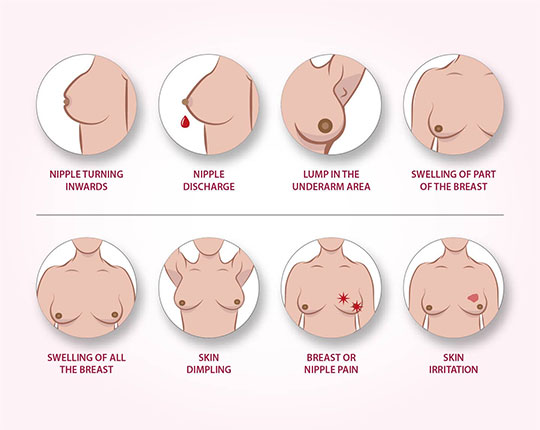Early Detection
Early detection means finding the cancer before it spreads. Breast cancer cannot be prevented, but early detection provides the greatest possibility of successful treatment.

HOW CAN BREAST CANCER BE DETECTED EARLY?

Other ways by which Breast Cancer can be detected early are :
- Regular breast cancer screening has been shown to decrease the risk of dying from the disease.
- It is advised from 25yrs. of age to get familiar with your breasts and do a breast self examination (BSE) every month.
- From 35yrs. get your breast checked by a doctor annually or every two years.
- Once you cross 45 ask your doctor if you need to have a mammogram as it is advisable to get one every two years or so.
BREAST SELF- EXAMINATION
Breast self-awareness can help you become familiar with how your breasts normally look and feel. Knowing this will help you identify any changes in your breasts that should be reported to your health care professional promptly. If you find a lump, schedule an appointment with your doctor, but don’t panic – most lumps are not cancer.


Changes to look for include:
- A lump or thickening in or near the breast or in the underarm area
- A change in the size or shape of the breast
- Dimpling or puckering in the skin of the breast
- A nipple turned inward into the breast
- Discharge (fluid) from the nipple
- Scaly, red, or swollen skin on the breast, nipple, or areola (the dark area of skin at the center of the breast)
- Edema , swelling or recent change in the thickness in the skin of the breast making it look like an orange peel
- A swelling or a lump in the arm pit without any changes in the breast
You should see your health care provider about any of these symptoms. Often these symptoms are not due to cancer, but if you notice any changes in your body, tell your health care provider immediately so that the problems can be diagnosed and treated.
ANNUAL EXAMINATION BY A DOCTOR
It is recommended that women visit their family physician or gynecologist each year for an examination. In addition to a routine pelvic exam and pap smear, the doctor may perform a brief breast exam to check for abnormalities. It is a great opportunity for you to discuss with your health care provider any questions or concerns you have regarding your breast health. For example, your doctor may help you determine the most appropriate personalized frequency for your early detection steps.

MAMMOGRAM
A mammogram is an x-ray of the breast At times the doctors may request for a mammogram just to screen the breast for any abnormalities or if he / she finds any signs of breast cancer
Such signs may include:
- A lump
- Breast pain
- Nipple discharge
- Thickening of skin on the breast
- Changes in the size or shape of the breast
A diagnostic mammogram can help determine if these symptoms are indicative of the presence of cancer.As compared to screening mammograms, diagnostic mammograms provide a more detailed x-ray of the breast using specialized techniques.

How Reliable Are Mammograms For Detecting Cancerous Tumors?
The ability of a mammogram to detect breast cancer may depend on the size of the tumor, the density of the breast tissue, and the skill of the radiologist administering and reading the mammogram. Mammography is less likely to reveal breast tumors in women younger than 50 years than in older women. This may be because younger women have denser breast tissue that appears white on a mammogram. Likewise, a tumor appears white on a mammogram, making it hard to detect.